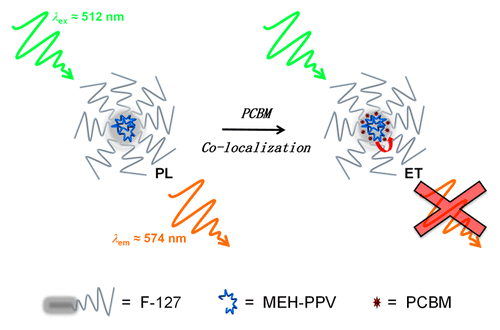The objective of this work is to demonstrate that conjugated polymer:fullerene hybrid nanoparticles encapsulated in the hydrophobic cores of triblock copolymer micelles may successfully act as spatially confined donor–acceptor systems capable of facilitating photoinduced charge carrier separation. To this end, aqueous dispersions of poly[2-methoxy-5-(2-ethylhexyloxy)-1,4-phenylenevinylene] (MEH-PPV) nanoparticles were first prepared by solubilization of the polymer in the cores of poly(oxyethylene)–poly(oxypropylene)–poly(oxyethylene) triblock copolymer, Pluronic F-127 micelles. A number of significant optical spectroscopic changes were observed on transfer of the conjugated polymer from a nonaqueous solvent to the aqueous micellar environment. These were primarily attributed to increased interchain interactions due to conjugated polymer chain collapse during encapsulation in the micellar cores. When prepared in buffer solution, the micelles exhibited good long-term collodial stability. When MEH-PPV micelles were blended by the addition of controlled amounts of [6,6]-phenyl-C61-butyric acid methyl ester (PCBM), the observed correspondence of photoluminescence emission quenching, quantum yield decreases, and emission lifetime shortening with increasing PCBM concentration indicated efficient photoinduced donor-to-acceptor charge transfer between MEH-PPV and the fullerenes in the cores of the micelles, an assignment that was confirmed by transient absorption spectroscopic monitoring of carrier photogeneration and recombination.
